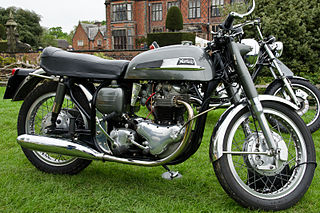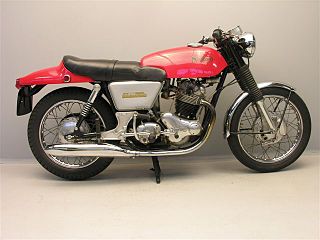
The Norton Motorcycle Company is a brand of motorcycles headquartered in Solihull, West Midlands,, England. For some years around 1990, the rights to use the name on motorcycles was owned by North American financiers.

Matchless is one of the oldest marques of British motorcycles, manufactured in Plumstead, London, between 1899 and 1966. A wide range of models were produced under the Matchless name, ranging from small two-strokes to 750 cc four-stroke twins. Matchless had a long history of racing success; a Matchless ridden by Charlie Collier won the first single-cylinder race in the first Isle of Man TT in 1907.

Triton motorcycles were hybrid motor cycles built from the 1950s to the 1970s that involved fitting Triumph engines into Norton frames. Because no factory offered Triton motorcycles, they were typically privately constructed. However, some UK dealers offered complete bikes. The aim was to combine the best elements of each marque and thus gain a bike superior to either. The name 'Triton' is a contraction of Triumph and Norton; 'Triton' was the name of a mythological Greek God.

The Ducati 750 Imola Desmo is a racing motorcycle built by Ducati that won the 1972 Imola 200 race in the hands of Paul Smart. This win helped define Ducati's approach to racing.
Norton-Villiers was a British motorcycle manufacturer formed in the 1960s following the collapse of AMC. With the general decline of the British motorcycle industry, under a British Government initiative it was later combined with the remnants of BSA Triumph to form Norton-Villiers-Triumph.

The Norton Commando is a British Norton-Villiers motorcycle with an OHV pre-unit parallel-twin engine, produced by the Norton Motorcycle company from 1967 until 1977. Initially having a nominal 750 cc displacement, actually 745 cc (45.5 cu in), in 1973 it became an 850 cc, actually 828 cc (50.5 cu in). It had a hemi-type head, similar to all OHV Norton engines since the early 1920s.

The Dominator is a twin cylinder motorcycle developed by Norton to compete against the Triumph Speed Twin. The original Dominator was designed in 1947 and 1948 by Bert Hopwood, who had been on the Speed Twin design team at Triumph. Available for sale from mid 1949, this design set the pattern for Norton twins for the next 30 years.

The Matchless G12 is a British motorcycle made by Associated Motor Cycles at the former Matchless factory in Plumstead, London. Developed in 1958 specifically to capture the potentially lucrative US market, the last G12 was produced in 1966.

The featherbed frame was a motorcycle frame invented by the McCandless brothers and offered to the British Norton motorcycle company to improve the performance of their racing motorcycles in 1950. It was considered revolutionary at the time, and the best handling frame that a racer could have. Later adopted for Norton production motorcycles, it was also widely used by builders of custom hybrids such as the Triton, becoming legendary and remaining influential to this day.

The Dunstall Norton was a Norton motorcycle made by Paul Dunstall, a specialist tuner of the 1960s and early 1970s twins originally using some parts from Norton's Domiracer project when the Birmingham factory was closed in 1963. In 1966 Dunstall Motorcycles became a motorcycle manufacturer in its own right so that Dunstalls could compete in production races, and set a number of world records before sales of the Dunstall Nortons declined in the 1970s consistent with the demise of the British motor cycle industry and a corresponding rise in Japanese imports.

The Norton P11 is a 745 cc (45.5 cu in) air-cooled OHV parallel twin motorcycle that was made by Norton-Villiers from 1967 to 1969. Designed as an extremely light high power-to-weight ratio desert racer, P11 was revised in 1968 to the P11A and marketed as the Norton Ranger, a road legal version of the P11 with a more comfortable seat to make it suitable for normal road use. The Norton P11 gained a reputation as a 'desert racer' in the late 1960s but by 1969 lighter two stroke desert racers began to dominate the sport and the Norton had begun Commando production and it was selling well. Norton ended production of the P11 series to concentrate on the Commando, which used a number of ideas developed on the P11 series.

The isolastic frame, designated by Norton as GlideRide, used a system of engine-to-frame mountings incorporating rubber bushes to isolate the vibration of the vertical twin engine from the frame and rider. The isolastic frame was developed for use with the Commando inclined engine, whilst the Featherbed frame continued in production for the Mercury with a softer-specification 650 cc vertical-engine until 1970.

Colin Jordan Seeley was a British motorcycle retailer who later became a motorcycle sidecar racer, motorcycle designer, constructor and retailer of accessories. In 1992 he was involved in running the Norton Rotary race team.

The Norton Commando Production Racer was a hand built production racer produced by Norton-Villiers from 1970 - 1972. It was based on the road-going Norton Commando, and although fitted with lights it was never intended as a road bike. The model was commonly known as the Yellow Peril.
The Norton Nomad was a dual-sport motorcycle produced for the American market between 1958 and 1960 by the British manufacturer Norton. The machine was available with either 500 or 600 cc twin cylinder engines and was produced in small quantities, around 50 of the smaller engine and around 300 600 cc machines. The first Nomad imported to the US finished 8th in California's Big Bear Run. 822 competitors has started the race. The 600 Nomad was designated with model number N15 (1958), P15 (1959) and R15 (1960). The 500 was designated N16/P16/R16. The Nomad was the first in a line of on/off road machines which culminated in the Ranger.

The Norton Model 88 Dominator, also originally known as the Dominator De Luxe was a 500 cc vertical twin motorcycle manufactured by the British Norton Motorcycle Company from 1952 to 1966. It was the first of Norton's motorcycles to use the featherbed frame, which established Norton's reputation of producing fine handling machines. The 88 used the Bert Hopwood designed engine that was first fitted to the Model 7 and was initially for export only. It became available on the home market in 1953. Norton were a small manufacturer at the time and without the economies of scale the model was expensive compared to other manufacturer's equivalent machines. The 88 retailed for 20% more than the contemporary Triumph Speed Twin and was dearer than the 650 cc Triumph Thunderbird.

The Norton Model 99 Dominator was a 600 cc vertical twin motorcycle manufactured by the British Norton Motorcycle Company at their Bracebridge St, Birmingham factory from 1956 to 1962. The 99 was based on the 500 cc Model 88 Dominator with an enlarged engine. The model was superseded by the 650SS.
The Norton Manxman was a 650 cc vertical twin motorcycle manufactured by the British Norton Motorcycle Company at their Bracebridge St, Birmingham factory for export. The engine was an enlargement of the 600 cc engine used in the Model 99 Dominator. The Manxman was first shown at the November 1960 Earls Court Motorcycle Show and listed by the American importer, Berliner, in their catalogue from 1961 to October 1962 Berliner had asked for the model to be named Manxman although the twin had never been raced at the Isle of Man.

The Norton 650 Dominator was a 650 cc vertical twin motorcycle manufactured by the British Norton Motorcycle Company from 1962 to 1967. Initially production was at Norton's Bracebridge St, Birmingham factory, but following the factory's closure in 1963, production was transferred to parent company AMC's works in Plumstead, London. Initially produced in single and twin carburettor versions, the single carb version was soon discontinued. The twin carb version, the 650SS, was described as the 'Best of the Dominators'.

The Norton Mercury was a 646 cc (39.4 cu in) air-cooled OHV parallel twin motorcycle made by Norton-Villiers from 1968 to 1970. It was the last Norton model to use the 'featherbed' frame. Following the collapse of AMC and the subsequent formation of Norton Villiers, the company's focus had been on the new Norton Commando. There was a large inventory of parts from previous models that would not be used on the Commando, and to use up this stock the Mercury was conceived. The Mercury was introduced in October 1968 and around 750 machines were produced, most of the production going to the US. The model was also used by the Nigerian Police.

















